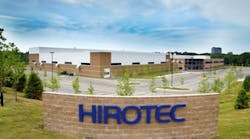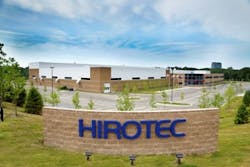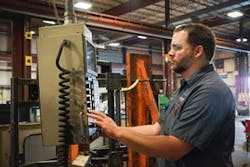Automotive parts supplier launches IIoT initiative
Figure 1. Hirotec Group, a $1.6 billion corporation with more than 60 years of engineering and mass production experience and 26 facilities in nine countries around the world, is a global automation manufacturing equipment and parts supplier.
For more than 50 years, vehicle producers such as General Motors and Mazda have used industrial manufacturing concepts and systems from Hirotec America in Auburn Hills, Michigan (Figure 1). Hirotec Group, a $1.6 billion corporation with more than 60 years of engineering and mass production experience and 26 facilities in nine countries around the world, is a global automation manufacturing equipment and parts supplier.
“Hirotec is a Tier-One component and tooling supplier for the automotive industry, giving us a very unique perspective on how both sides of the industry operate,” says Justin Hester, senior researcher, Hirotec. “We’ve used this insight to benefit both our business and our customers by designing and building a wide array of state-of-the-art solutions that are based on proven concepts. In our dedication to our customers’ success, we pride ourselves on our ability to supply the highest-quality automotive equipment and services to customers around the world.”
Operational downtime is a significant issue facing original equipment manufacturers (OEMs). In most cases, the machinery involved runs without condition-based monitoring—essentially operating until a failure occurs. At that time, appropriate personnel are contacted to assess the situation and make the repairs as expeditiously as possible to prevent dramatically delaying production schedules. Outside factors such as weather or traffic patterns might also add to possible downtime scenarios and lead to organizational inefficiencies or misallocation of resources.
Figure 2. Hirotec needed to implement a modern, automated solution that could gather maintenance and operational information into one source and offer actionable recommendations to its quality professionals.
Hirotec sought to eliminate this trend of reactive maintenance and lost opportunities by utilizing the information and systems it had on hand to gain deeper insight into its operations and processes. The automotive supplier had long collected industrial data from sensors and machines across customer production facilities and its own systems to support its decisions and track business progress. However, volumes of this data were manually separated and stored across multiple sources, making it inaccessible to collective and systematic analysis. In order to improve quality, reduce downtime and optimize production schedules, Hirotec needed to implement a modern, automated solution that could gather maintenance and operational information into one source and offer actionable recommendations to its quality professionals (Figure 2).
“A lack of data was never an issue for us,” says Hester. “As one of the largest automotive manufacturing suppliers in the world, we collect volumes of data sets on a daily basis. The problem we were faced with was transitioning from a data-heavy organization to a data-smart organization. We realized that in order to bolster profits from untapped machine-generated information, we needed to look toward modern solutions that automated the process and enabled timely, data-driven decisions.”
How do you leverage IIoT?
Recognizing the need for connectivity, data access and scalability, executives at Hirotec worked to develop a competitive strategy to capitalize on the potential benefits of the Industrial Internet of Things (IIoT). The initiative began with identifying the fundamental technologies that would fuel the IIoT effort. After evaluating several traditional offerings from traditional industrial automation vendors, Hirotec found that many solutions were restricted to a single business aspect, protocol or standard.
“Hirotec did extensive research and met with many of the large factory automation solution providers to discuss IoT tools and solutions before selecting PTC ThingWorx and Kepware,” says Hester. “This decision was based on PTC’s clear vision for IoT in manufacturing, the comprehensive solution ecosystem that PTC provides and its universality in being able to connect with any automation control system or data stream across the enterprise.”
Not wanting to waste time and effort integrating multiple solutions across several business functions, Hirotec finally turned to Kepware’s KEPServerEX and the ThingWorx IoT Platform—both solutions from PTC—to enable company-wide device-to-cloud connectivity through one overarching toolset. Working together to deploy a single source of smart solutions for the IIoT, the ThingWorx platform would be able to provide analytical insight into Hirotec’s data through industrial data streamed from the IoT gateway for KEPServerEX, a plug-in capable of pushing information from KEPServerEX into big-data and analytic software applications. To support the company’s long-term IIoT vision, Hirotec collaborated with representatives at PTC to build an IoT framework supported by short, six -week Agile sprints.
“A growing trend in the industrial sector is the desire to take an agile approach to the implementation of software,” explains Hester. “With an agile approach, you define a very specific problem or user story you want to solve, and then you take a short period of time—two to six weeks, a sprint—to implement the hardware and software to solve the use case.”
This approach is in contrast to the typical manufacturing execution system (MES) or enterprise resource planning (ERP) implementation where you take many months or years to perform plant or corporate-wide technology rollouts. “IIoT technologies are allowing this to happen at this fast pace at a reasonable price point and allowing the solution to scale as more user stories are implemented in a factory,” says Hester.
“Scrum is a subset of agile and is useful for the rapid delivery of high-quality software,” explains Hester. “It is an agile software development process based on multiple small teams working in an intensive and interdependent manner. Hirotec leveraged the scrum model in its North American shop in Detroit, the test bed for the first small sprint.”
Scrum is distinguished from other agile processes because of its particular concepts and practices. These small, collaborative and goal-oriented teams, enable organizations to adjust smoothly to rapidly-changing requirements and produce a product that meets evolving business goals.
ALSO READ: The IoT starts with common and proper things
Scrum and visibility
Where a full IoT implementation may have taken years to generate a proof of concept, the scrum model provided company executives with visible and quantifiable progress in just weeks. “We see and speak with many manufacturing organizations,” says Hester. “It is clear they are interested in the Internet of Things. They see the potential and would like to do something with the technology. Despite the desire that exists, many remain frozen because the prospect of a full-blown implementation is so daunting and uncertain.”
This is why Hirotec advocates so strongly for the short-sprint model it’s adopted, explains Hester. “We don’t want to boil the ocean; we want to start with low-hanging, solvable problems and build out our case and experience.”
Hirotec’s North American shop in Detroit was chosen as the testbed for the first small sprint because of the unique data types generated among its eight computer numerical control (CNC) machines. Kepware’s IoT Gateway for KEPServerEX collects data from the CNC machines and streams it in real-time to the cloud, where the ThingWorx IoT Platform provides analytics and data visualizations. This solution gives Hirotec labor-free access to a customized visualization of both the operations and conditions of its industrial devices and systems. “When first embarking on our IoT journey, Hirotec’s core objective was to remain flexible in our ability to connect things,” says Hester. “The offerings and expertise by Kepware and PTC have enabled us to stay true to our goal by effortlessly adapting to our business processes and developing the right IoT strategy for our teams. The IoT Gateway’s ability to seamlessly put data into ThingWorx to generate real-time insight into operations fuels our sprint framework and allows us to stay nimble in our decision making.”
Since implementing Kepware’s IoT Gateway and the ThingWorx IoT Platform, Hirotec has gained increased visibility into the processes of its CNC shop and deeper insight into operations.
The company realized early on that having access to CNC machine uptime data significantly impacted the shop’s scheduling process, which was previously set on conjecture and after-the-fact analysis. Manufacturing leadership can now leverage real-time data from the shop floor and tie it to the scheduling ERP system, optimizing the scheduling of parts to CNC modules. This process also provides greater insight into asset and resource allocation by automatically formulating smarter questions about current needs and priorities and determining the most effective course of action. Because of this, Hirotec has improved productivity across the shop and increased its ROI.
The company has also improved collaboration between its operations and information technology (IT) departments. By working daily with research and development engineers, IT teams quickly gained access to corporate roadmaps and strategic goals and were empowered to contribute at a more strategic level. Not only has the development of cross-functional teams improved communications across the entire business, but the added perspective helps to promote quicker and more efficient responses to IT jobs. Hirotec anticipates its IIoT efforts to impact every aspect of its business—from operations and IT to financial forecasting, customer relations and sales
As it moves forward with sprint projects, Hirotec will continue to see what is useful about the varied sets of contextualized data and use it to create common business processes and analyses. The auto parts supplier eventually plans to use this insight to create an IIoT-ready production line and enable remote equipment monitoring and management from a centralized dashboard to promote predictive and proactive maintenance.
“In just six short weeks, we’ve gained more visibility into our operations than ever before, reinforcing our investment and belief in the power of the IoT,” says Hester. “With data-centric knowledge generated from KEPServerEX and ThingWorx, we can now make smarter and timelier decisions that not only impact our CNC shop, but also help us identify how we can operate more efficiently and profitably across all of our facilities.”
- Improved visibility into the processes of the CNC shop and gained deeper insight into operations
- Added the ability to leverage real-time data from the shop floor and tie it to the scheduling ERP system, optimizing the scheduling of parts to CNC modules
- Increased productivity and ROI by gaining greater insight into asset and resource allocation
- Improved collaboration between operations and information technology (IT) departments, reducing downtime and enabling more efficient responses to IT jobs
- Reduced costs, effort and development time by selecting proven, interoperable technologies
- Provided quick proof-of-concept into the value of IoT via short, six-week Agile sprints.
Mike Bacidore is the editor in chief for Control Design magazine. He is an award-winning columnist, earning a Gold Regional Award and a Silver National Award from the American Society of Business Publication Editors. Email him at [email protected].








